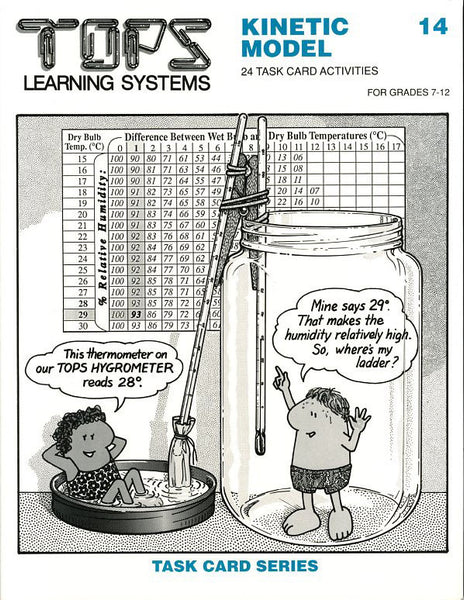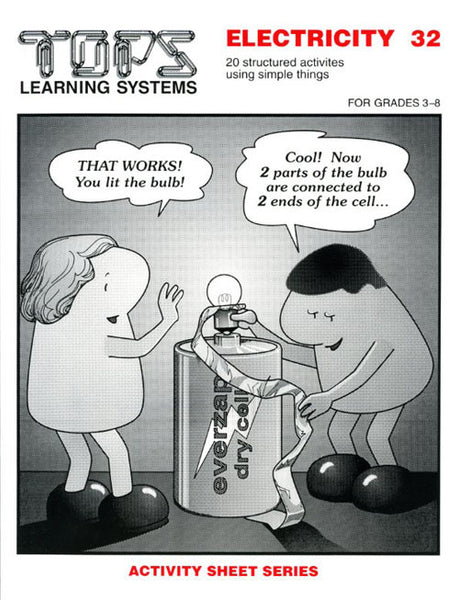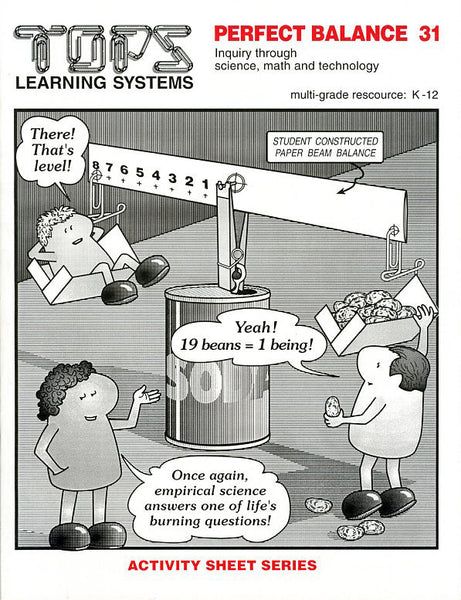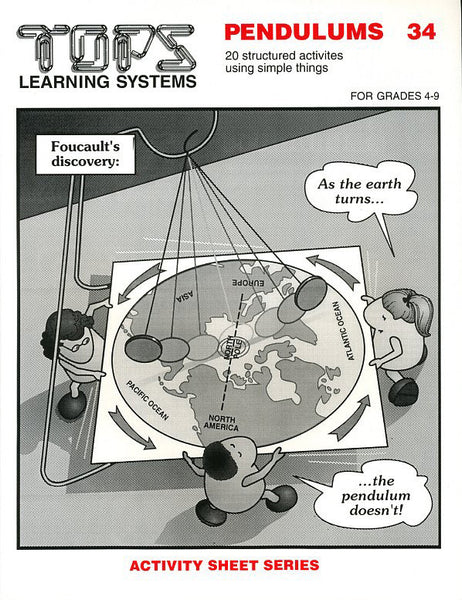#14 Kinetic Model (grades 7-12)
Regular price $20.95
Soft-bound, 64 page book, 24 reproducible task cards, full teaching notes.
How can we determine the nature of things we can't see? Experiment with making inferences. Apply these reasoning skills to investigate the nature of solids, liquids and gases. Discover matter as a collection of particles in constant thermal motion through a variety of phenomena – diffusion, expansion, contraction, condensation, more. Whew!
Kinetic Model Starter Kit
book not included, please order separately
WE SUPPLY in quantities that serve one student or two students working in a lab pair: aluminum foil, index card, masking tape, clear tape, plastic jars, graduated cylinders, thermometers (12" glass), heavy-duty D-cell batteries, straws, test tubes, syringe, pipettes, tubing, food coloring, magnet, clothespin, emergency candle, birthday candles, modeling clay, rubber bands, paper clips, straight pins, styrofoam cups, hand lens, flashlight bulb
More Information – click any of the tabs below to learn more about this title
Click here for a complete list of materials and convenient shopping.
masking tape, scissors, pressed cardboard, milk cartons, quart or half gallon sizes, milk carton objects: washer, penny, bottle cap, tack, nail, rubber stopper, marble, BB, clay ball, half straw, AA battery, test tube, clothespin, a 5-link paper clip chain, microscope slide, magnets (optional), plastic produce bags, package popcorn, unpopped, dictionaries, baby food jars (or small jars), source hot and cold water, cider jug or equivalent, food coloring, wall clock, narrow clear plastic tubing, 1/8 inch diameter or less, test tubes, at least half should be large capacity, cup modeling clay (or a 1-hole rubber stoppers), eyedroppers, lab thermometers, lids for baby food jars (or other small jars), aluminum foil, ice cubes, table salt, paper towels, candles (may use Bunsen burners or alcohol lamps in some activities), books matches, wooden clothespins, cups snow or ice shavings, wax shavings, index cards, 4x6 inches (optional), styrofoam cups, sandwich bags, paper clips, bottle rubbing alcohol, rubber bands, roll plastic wrap, straight drinking straws, straight pins, hole punch tools, margarine tubs (or bowls), empty cans, hand lenses, roll toilet tissue, quart jars with lids, string, hot plate or radiator (optional), small diameter syringes, about 3 cc, plastic 2 liter bottles with lids, twist ties (or thin wire), hand calculators, rolls clear tape, birthday candles, size-D batteries, graduated cylinders, 100 mL capacity, and 10 mL capacity- Lesson 1: To devise ways to indirectly determine the shapes of cardboard patterns inside a milk carton.
- Lesson 2: To make inferences about the contents of a milk carton using indirect experimental evidence.
- Lesson 3: To develop a kinetic model for air trapped in a plastic bag.
- Lesson 4: To show by indirect experimental evidence that water molecules are in continuous motion.
- Lesson 5: To build an air thermometer that is sensitive to small temperature changes. To explain how it functions in terms of the kinetic model.
- Lesson 6: To observe and describe four phase changes in water. To interpret these changes on a molecular level.
- Lesson 7: To plot a heating curve for water. To recognize that temperature remains constant as water changes phase.
- Lesson 8: To plot a cooling curve for candle wax. To recognize that heat is lost as wax undergoes a phase change from liquid to solid.
- Lesson 9: To evaporate water in closed systems. To use the kinetic model to account for its dramatic increase in volume.
- Lesson 10: To understand why liquids cool as they evaporate.
- Lesson 11: To observe and explain the cooling effects of alcohol. To trace the movement of alcohol molecules through a permeable membrane.
- Lesson 12: To compare rates of evaporation in water and rubbing alcohol on a balance beam. To account for observed differences in terms of intermolecular bond strengths.
- Lesson 13: To condense water vapor against surfaces that are cooled by evaporation. To understand that evaporation and condensation form a dynamic equilibrium when humidity reaches 100%
- Lesson 14: To construct a hygrometer. To measure the relative humidity of room air and compare it to other sources.
- Lesson 15: To investigate the relationship between the pressure on a gas and its temperature.
- Lesson 16: To make a cloud in a bottle, To understand how pressure, temperature and relative humidity affect cloud formation.
- Lesson 17: To construct an apparatus for use in the next activity that detects small changes in length. To geometrically calculate real movement based on apparent movement.
- Lesson 18: To understand the expansion and contraction of aluminum foil in terms of the kinetic model. To measure its changing length.
- Lesson 19: To observe how a bi-material strip bends as its dissimilar sides expand and contract by different amounts.
- Lesson 20: To calculate the heat of fusion for ice.
- Lesson 21: To quantitatively measure the volume of air inside a test tube at two different temperatures.
- Lesson 22: To experimentally calculate absolute zero and compare it with the accepted value, To appreciate the physical significance of this ultimate cold.
- Lesson 23: To use the absolute zero graph to plot the average temperature of air inside a heated test tube.
- Lesson 24: To boil warm water in a syringe at low pressure. To interpret a simple phase diagram.
We encourage improvisation - it's one of the main goals of our hands-on approach! You and your students might invent a simpler, sturdier or more accurate system; might ask a better question; might design a better extension. Hooray for ingenuity! When this occurs, we'd love to hear about it and share it with other educators.
National Science Education Standards (NRC 1996)
Teachers of science...
A: ...plan an inquiry-based science program. (p. 30)
B: ...guide and facilitate learning. (p. 32)
C: ...engage in ongoing assessment of their teaching and of student learning. (p. 37)
D: ...design and manage learning environments that provide students with the time, space, and resources needed for learning science. (p. 43)
• Represent a central event or phenomenon in the natural world.
• Represent a central scientific idea and organizing principle.
• Have rich explanatory power.
• Guide fruitful investigations.
• Apply to situations and contexts common to everyday experiences.
• Can be linked to meaningful learning experiences.
• Are developmentally appropriate for students at the grade level specified.
Core Concepts/Processes: Matter exists as a solid, liquid, or gas, depending on temperature and pressure. • Under constant pressure, a volume of air (V) shrinks in direct proportion to temperature (T). Plot T vs. V, then extrapolate the straight line to absolute zero, where all thermal motion stops.
Core Inquiries: Make inferences about atoms and molecules based on indirect evidence.
Core Content:States of matter • Thermal motion • Phase changes • Evaporation • Humidity • Bimetal strips • Absolute zero
Core Content: Design a hygrometer and measure humidity. • Invent a bimetal strip. • Build a balance to observe evaporation as it happens.
TEACHING Standards
These 24 Task Cards promote excellence in science teaching by these NSES criteria:Teachers of science...
A: ...plan an inquiry-based science program. (p. 30)
B: ...guide and facilitate learning. (p. 32)
C: ...engage in ongoing assessment of their teaching and of student learning. (p. 37)
D: ...design and manage learning environments that provide students with the time, space, and resources needed for learning science. (p. 43)
CONTENT Standards
These 24 Task Cards contain fundamental content as defined by these NSES guidelines (p. 109).• Represent a central event or phenomenon in the natural world.
• Represent a central scientific idea and organizing principle.
• Have rich explanatory power.
• Guide fruitful investigations.
• Apply to situations and contexts common to everyday experiences.
• Can be linked to meaningful learning experiences.
• Are developmentally appropriate for students at the grade level specified.
Unifying Concepts and Processes
NSES Framework: Systems, order, and organization • Evidence, models and explanation • Constancy, change, and measurement • Evolution and equilibrium • Form and functionCore Concepts/Processes: Matter exists as a solid, liquid, or gas, depending on temperature and pressure. • Under constant pressure, a volume of air (V) shrinks in direct proportion to temperature (T). Plot T vs. V, then extrapolate the straight line to absolute zero, where all thermal motion stops.
Science as Inquiry (content standard A)
NSES Framework: Identify questions that can be answered through scientific investigations. • Design and conduct a scientific investigation. • Use appropriate tools and techniques to gather, analyze, and interpret data. • Develop descriptions, explanations, predictions, and models using evidence. • Think critically and logically to connect evidence and explanations. • Recognize and analyze alternative explanations and predictions. • Communicate scientific procedures and explanations. • Use mathematics in all aspects of scientific inquiry.Core Inquiries: Make inferences about atoms and molecules based on indirect evidence.
Physical Science (content standard B)
NSES Framework:Heat • Properties and changes of properties in matter • Motions and forces • Transfer of energy • Interactions of energy and matterCore Content:States of matter • Thermal motion • Phase changes • Evaporation • Humidity • Bimetal strips • Absolute zero
Science and Technology (content standard E)
NSES Framework: Abilities of technological design • Understanding about science and technologyCore Content: Design a hygrometer and measure humidity. • Invent a bimetal strip. • Build a balance to observe evaporation as it happens.






